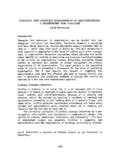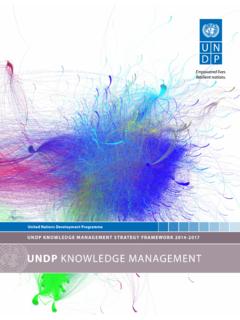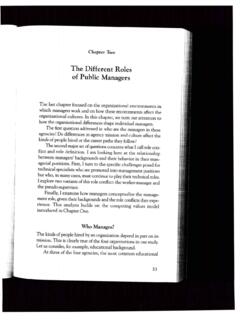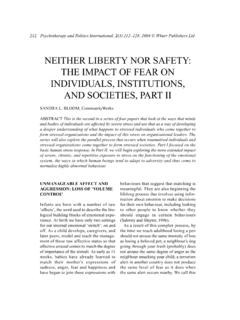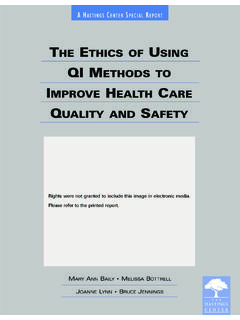Transcription of Board/Executive Director Tensions - Board Coach
1 Governance Matters Board Leadership Tool Page 1 Board / executive Director TensionsThe Board of Director s oversight role brings a fundamental tension to the Board / executive Director relationship. Who is ultimately in charge here? There are no firm guidelines about where Board oversight leaves off and executive management begins. In this grey area, struggles for power and authority often emerge. SymptomsFor Effective Nonprofits307 Seventh Avenue, Suite 1603 New York, NY 10001tel fax Perspective The executive Director gets so defensive when I ask her for something. The executive Director won t let us exercise proper fiscal oversight. The first I heard about our funding cuts was in the newspaper. The executive Director doesn t recognize my authority. I m not sure the executive Director is right for the job, but I don t want to say anything that would offend him. If Bob doesn t stop sending me those nasty emails I swear I m going to quit!
2 executive Director Perspective The Board is questioning everything I do. I can t even order stationery without the Board wanting to get involved. I don t want the Board breathing down my neck when things are so tough right now. The Board chair doesn t recognize my authority. The Board doesn t trust me. If Judy doesn t stop sending me those nasty emails I swear I m going to quit!Governance Matters Board Leadership Tool Page 2 Root Causes Why Tensions Develop Between Board Members And The executive Director1. Lack of information or Board members are unclear about the difference between governance and management. Management issues are more familiar to most people than governance issues. So the concrete tasks of hiring, project manage -ment, or editing the newsletter are easier to understand than more conceptual activities such as setting policy, strategies and exercising oversight. Execu-tive directors complain that this leads Board members to ask for, or even demand, detailed information that they do not really need in order to fulfill their fiduciary, governing and oversight responsibilities.
3 B. executive directors are unclear about the Board s role. An executive Director may interpret requests for information as a lack of trust in his/her competence, a lack of respect, or a lack of appreciation for his/her work. executive directors do not always understand the Board s responsibilities, and can resent Board members who ask for information that they legitimate-ly need for oversight. c. Board members are unfamiliar with the scope of the organization s work and day to day management concerns. Often Board members do not receive adequate orientation to the organization, its programs and its environment, and they do not take the time to learn about the organization on their own. As a result, they lack the information they need to provide adequate oversight. This does not prevent some Board members from shooting from the hip and otherwise challenging the executive Director without taking time to understand the context in which s/he is Changea.
4 Board and executive Director roles shift. Common causes for a change in Board and executive Director responsibilities include: A shift from a volunteer-led organization to one with professional management. Board members who have been used to making day-to-day operational decisions as an all-volunteer organization can have a hard time moving an oversight role. They have an investment in the new executive Director continuing to do things they way they were done by the old Board , which can stifle a new executive Director . The transition from one executive Director to the next. If there has been a transition period in which Board members have had to assume some of the day-to-day management of the organization, it can be difficult for those same Board members to step back into their governance Matters Board Leadership Tool Page 3b. The needs of the organization have changed and/or are unclear. The same person who was just right for the last phase of the organization s development may not have the skills needed to take the organization to the next phase.
5 In that case, the executive Director feels pressure to do things that were not part of what s/he signed up for however many years ago, and does not feel competent to take on the new roles. Also, new organizational challenges and needs may not be clear at the Board level, leaving Board members with a feeling of dissatisfaction due to insufficient measures for progress. 3. Board practices do not support their oversight Board members lack focus. If people do not know where to look, they focus on the first thing they see. This is why a Board member with no financial training inevitably starts asking about the $5,000 postage line when the budget to actual report shows a $100,000 deficit. Also, if Board members do not have a clear understanding of what they should be doing, but still want to be involved, they often grab onto something familiar and try to exercise authority in that area, whether or not it is warranted or There are no appropriate mechanisms for evaluating the executive Director .
6 In the absence of agreed upon measures and a defined process to evaluate the executive Director s performance, Board members can only rely on subjective judgments. And if there is no structured way for the Board to give feedback to the executive Director , concerns about performance may be expressed in any number of counterproductive and even harmful ways. c. There is not a way to effectively communicate priorities and decisions from the Board to the executive Director . In the absence of established and agreed upon communications protocols, executive directors are likely to feel that they report to twenty-six separate bosses rather than one Board of direc-tors. In these situations, every individual Board member s request, program idea or personal priority can become a mandate. Board members then feel resentful and unappreciated when the executive Director does not respond in accordance with their individual preferences, suggestions or Matters Board Leadership Tool Page 44.
7 Incompatible assumptions and Some executive directors do not want to be held accountable by the Board . An executive Director has to manage staff, figure out how to achieve program goals, raise money, balance the budget and represent the organiza-tion to the outside world, and those are just the formal roles! It is an enor-mous responsibility. As organizational leaders, executives need freedom and flexibility to make decisions based on their professional experience and judgment, and can be resentful of a Board that wants to supervise them. To ensure their independence, some executive directors can try to control the Board by stacking the membership with allies, or by controlling the flow of information. These executive directors essentially wish that the Board would just leave them alone and go raise money and, as a result, they cannot understand why their Board is unresponsive or inactive. b. Board members behave in ways that make collaboration difficult.
8 We see behaviors in and out of the Board room that would never be tolerated in another setting. For example, some Board members take advantage of their oversight role and use it as an excuse to be the boss. This can translate into a range of bullying behaviors such as demanding inappropriate or unnecessary information and in unreasonable timeframes, or presenting frequent criticism of the executive Director . Other Board members may require extensive hand holding, requesting frequent phone or in-person meetings with the executive Director . c. Personalities clash. Underneath all of the accusations, it sometimes comes down to the fact that the executive Director and one or more Board members just cannot get along their styles or values are too different. Often one or the other will feel slighted or insulted, and s/he will lash out as a Matters Board Leadership Tool Page 5 What You Can DoHow Boards manage conflicts with the executive DirectorAs with any conflict, the solution is to get people talking and listening to one another.
9 Doing so requires the Board and executive Director to come to an under-standing of the issues at hand, and to design a series of conversations around the real issues. Depending on the nature of the root cause, one of the following approaches is likely to be helpful in resolving Clarify Board oversight roles and develop mechanisms that allow Board members to fulfill those Board self-assessment. One way to clarify roles and responsibilities, and develop oversight mechanisms is to engage the Board in a self-assessment. Usually self-assessment is done with a questionnaire that asks Board mem-bers to rate the Board on how well it fulfills governing functions. In this way the questionnaire is an effective tool to educate Board members about the functions they should be performing. The executive Director also completes the tool, and the Board s self-assessment can then compared with the execu-tive Director s assessment of the Board .
10 Typically those who complete the survey are also asked to identify the most important areas for improvement. Once the results are compiled, the Board and executive Director meet to discuss what the Board does well and where they need to improve. From this point of view they can then discuss what support they need from the executive Director in order to improve the way they are going about their governance duties. Outside professionals are often called on to help the Board create an action plan based on the findings from the self-assessment. b. Make time to discuss vision, strategy and policy. Too often, Board meetings are made up of reports from the executive Director and discussions center on the details of implementation. It s no wonder that Board members start to focus on matters that belong with management that s all they hear about! To change the focus, the executive Director and Board chair (or executive committee) need to work together to identify strategic issues and questions facing the organization.

